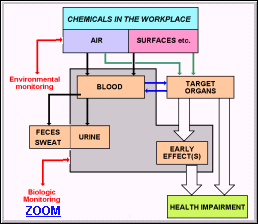 |
| Module 3: Toxicology - Section 4: Biological Monitoring |
| TOX 4.2: Lecture: Biological Monitoring and Biological Effect Monitoring |
 |
| Module 3: Toxicology - Section 4: Biological Monitoring |
| TOX 4.2: Lecture: Biological Monitoring and Biological Effect Monitoring |
OHSA: Regulations for hazardous chemical substances 1995. (Open up the book "Regulations", and then open the book "Hazardous Chemical Substances Regulations", 1995).
"an employer shall ensure that an employee is under medical surveillance if the employee may be exposed to a substance listed in Table 3"
Table 3: Substances for which BEIs exist..
Concentration of a substance in air, on surfaces, etc. (province of occupational hygiene).
Concentration of a substance in body tissue /excreta.
Reversible physiological effects of a substance on an organ system.

Early disease, or a marker of acquired or genetic susceptibility
(overlaps with biological effect monitoring).
Metals: arsenic*, cadmium, chromium VI*, mercury*, lead*;
Aromatic solvents: benzene*, ethyl benzene, chlorobenzene, nitrobenzene, phenol*, toluene*, xylene*;
Chlorinated solvents: Perchloroethylene*, trichloroethylene*, methylchloroform*;
Other solvents: carbon disulfide, dimethylformamide, methanol*, methyl ethyl ketone (MEK)*, methyl isobutyl ketone, n-hexane*, styrene;
Pesticides: parathion*, pentachlorophenol;
Miscellaneous: Aniline, carbon monoxide*, fluorides, furfural.
* You are more likely to encounter these in practice.

Postgraduate Diploma in Occupational Health (DOH) - Modules 3:
Occupational Medicine & Toxicology (Basic) by Profs Mohamed
Jeebhay and Rodney
Ehrlich,
Health
Sciences UCT is licensed under a
Creative
Commons Attribution-Noncommercial-Share Alike 2.5 South Africa License.
Major contributors: Mohamed Jeebhay, Rodney Ehrlich, Jonny Myers,
Leslie London, Sophie Kisting, Rajen Naidoo, Saloshni Naidoo. Source available
from here.
For any updates to the material, or more permissions beyond the scope
of this license, please email healthoer@uct.ac.za
or visit www.healthedu.uct.ac.za.
Last updated Jan 2007.
Disclaimer note: Some resources and descriptions may be out-dated. For
suggested updates and feedback, please contact healthoer@uct.ac.za.